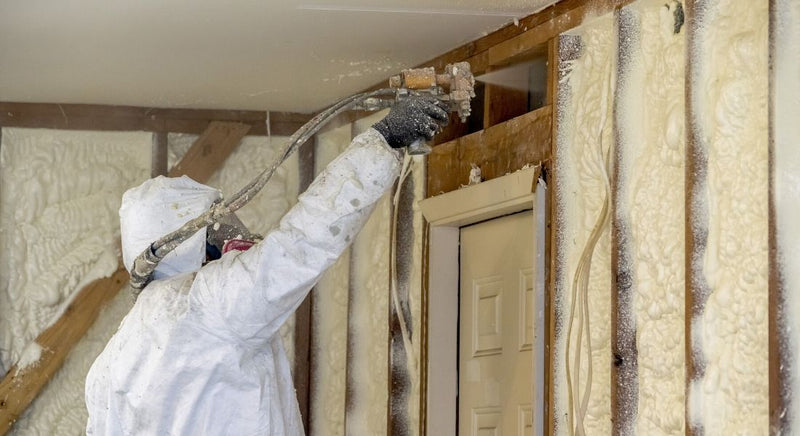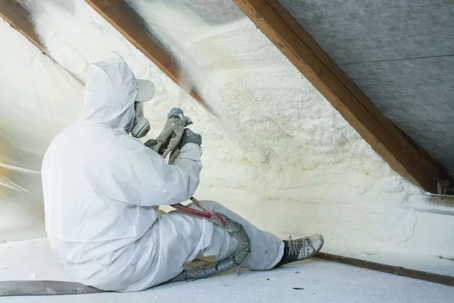Recognizing the Benefits of Using Spray Foam for Insulation Projects
Wiki Article
Spray Foam: The Ultimate Option for Air Sealing and Insulation
Spray foam insulation has actually arised as a leading remedy for effective air sealing and thermal insulation, using a distinct mix of properties that set it aside from typical approaches. Its capacity to broaden and fill up gaps makes it especially effective in preventing air leak, which can considerably impact power performance. Nevertheless, understanding the full extent of its advantages, setup processes, and contrasts with other insulation types is important for making educated choices. As we discover these facets, the ramifications for both brand-new building and constructions and retrofits end up being increasingly substantial. What factors should influence your option?What Is Spray Foam?
Spray foam is a functional insulation product that combines the concepts of air securing and thermal resistance to improve energy efficiency in buildings. Composed largely of polyurethane or various other comparable compounds, spray foam is applied as a liquid that increases upon call with surfaces, producing a strong, continuous layer of insulation. This special residential or commercial property enables it to load voids, cracks, and gaps that standard insulation products may neglect, giving a superior air seal.There are 2 main kinds of spray foam: open-cell and closed-cell. Open-cell spray foam is lighter and a lot more versatile, using excellent audio absorption and a reduced R-value per inch - Spray Foam. In comparison, closed-cell spray foam is denser, providing a greater R-value, wetness resistance, and added structural honesty to constructing components
The application procedure usually involves specialized equipment, guaranteeing a smooth application that sticks to various substratums, including concrete, timber, and steel. This flexibility makes spray foam ideal for both new constructions and retrofitting existing structures. Its ability to create an airtight barrier considerably contributes to lowering power intake and boosting indoor air high quality, thus making it a recommended choice amongst homeowners and building contractors alike.
Benefits of Spray Foam Insulation
One of one of the most considerable advantages of spray foam insulation is its outstanding capacity to produce a continuous air barrier, which efficiently reduces energy loss. Unlike standard insulation products, spray foam broadens to fill up voids and splits, ensuring that air leak is substantially minimized. This characteristic not just enhances power effectiveness yet likewise results in decrease utility bills gradually.
Additionally, spray foam insulation provides superior thermal resistance, adding to a more secure indoor setting. Its high R-value per inch enables for effective insulation in constrained areas, making it optimal for attic rooms, walls, and crawl areas. Moreover, the moisture-resistant residential properties of spray foam aid stop mold and mold development, advertising healthier living conditions.
One more important advantage of spray foam insulation is its sound-dampening qualities (Spray Foam). It efficiently minimizes sound transmission in between areas, creating a quieter and much more comfortable home atmosphere. The resilience of spray foam likewise attracts attention, as it does not sag or work out gradually, keeping its efficiency throughout its life-span
Just How Spray Foam Functions
Comprehending exactly how spray foam insulation functions is necessary for appreciating its performance in air securing and thermal resistance. Spray foam insulation contains two main elements: isocyanate and polyol material. When these components are blended, they undertake a chemical reaction that creates the Full Article material to increase rapidly, producing a thick foam that loads spaces, cavities, and fractures.As the foam broadens, it adheres to surface areas, creating an airtight seal that dramatically minimizes air seepage. This particular makes spray foam insulation very efficient at preventing drafts and moisture penetration, which can cause power loss and damage in time. In addition, the closed-cell variation of spray foam uses remarkable thermal resistance as a result of its rigid framework, successfully reducing warmth transfer.
The distinct buildings of spray foam enable it to adapt uneven surface areas, making sure comprehensive protection and a smooth barrier. As a result, spray foam insulation not just enhances energy performance however additionally contributes to enhanced interior air quality by minimizing the buildup of allergens and contaminants. Eventually, recognizing the technicians behind spray foam underscores its function as a remarkable choice for insulation and air sealing in both industrial and household applications.
Installation Process Introduction

Prior to visit their website installment, the room must be sufficiently cleaned up and prepped, making certain that surfaces are without dirt, dampness, and particles. Since contaminants can compromise adhesion and general efficiency, this action is crucial. When the location is prepared, the application entails mixing the 2 parts of the spray foam, which expands upon contact and fills up voids efficiently.
Educated professionals must conduct the installment, utilizing specialized devices to make certain uniform coverage and ideal thickness. Safety and security preventative measures, including wearing protective gear and making certain proper ventilation, are essential during this procedure. After application, the foam commonly cures quickly, creating a strong barrier that boosts energy performance.
Comparing Spray Foam to Conventional Insulation
When assessing insulation choices, spray foam insulation stands apart in contrast to standard products such as fiberglass and cellulose. One of the key advantages of spray foam is its superior air sealing capabilities. Unlike fiberglass and cellulose, which can enable air seepage, spray foam expands upon application, filling up holes and spaces to develop a closed seal. This causes improved power effectiveness, as less warmed or cooled air runs away the home, causing reduced energy bills.Additionally, spray foam gives a greater R-value per inch than standard insulation kinds, using even more effective thermal resistance in a thinner profile. This particular is particularly useful in spaces with limited dental caries deepness. Spray foam is immune to moisture and mold and mildew development, which can be a considerable issue with cellulose and fiberglass, specifically in damp environments.
Nonetheless, spray foam insulation normally carries a higher in advance cost than its standard equivalents. Home owners should evaluate this first investment against lasting energy cost savings and efficiency advantages. Eventually, while both insulation kinds offer their objective, spray foam arises as a more advanced solution for contemporary insulation needs, particularly in terms of air sealing and thermal efficiency.

Conclusion
In summary, spray foam insulation represents a highly efficient service for attaining ideal air sealing and thermal resistance. Its distinct buildings, consisting of moisture resistance and noise dampening, make it appropriate for numerous applications in both new constructions and retrofitting projects (Spray Foam). Although the preliminary expenses may be greater contrasted to conventional insulation products, the long-term advantages, such as significant power financial savings and boosted indoor air top quality, validate the financial investment and highlight its value in modern structure practices.Spray foam insulation has emerged as a leading solution for effective air securing and thermal insulation, supplying an one-of-a-kind mix of residential properties that set it apart from conventional methods.Spray foam is a versatile insulation product that incorporates the concepts of air sealing and thermal resistance to enhance power effectiveness in buildings.When assessing insulation choices, spray foam insulation stands out in comparison to traditional materials such as fiberglass and discover here cellulose. Inevitably, while both insulation types serve their purpose, spray foam emerges as an extra innovative option for contemporary insulation needs, particularly in terms of air securing and thermal performance.
In summary, spray foam insulation represents an extremely effective solution for achieving optimum air securing and thermal resistance.
Report this wiki page